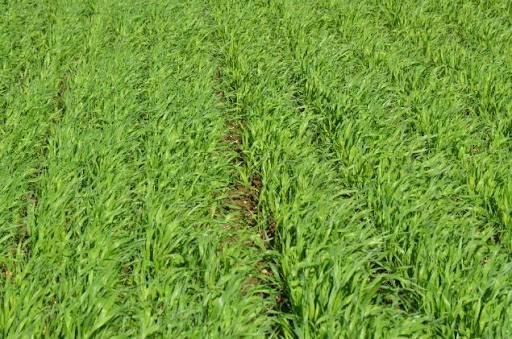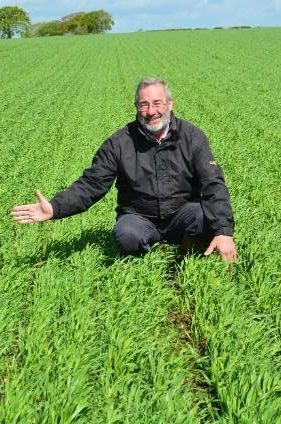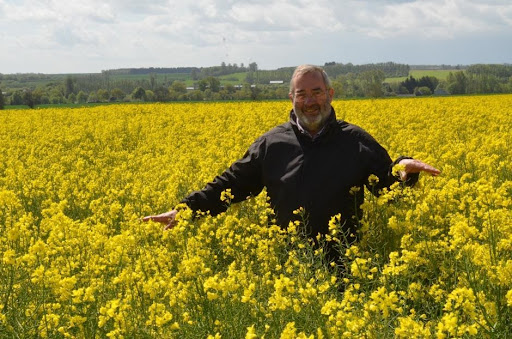
Jeff Claydon, Suffolk farmer and CEO of Claydon Yield-o-Meter Ltd – the company is celebrating its 40th anniversary this year.
———————————————————————————————————————————
28 May 2021
2021 marks the 40th anniversary of Claydon Yield-o-Meter Limited, so naturally, we would have liked nothing more than to welcome visitors to our Open Days to view our farm and factory but, as in 2020, that has not been possible.
The ongoing uncertainties over the coronavirus and government policy have again forced us to postpone any physical event and so this week we have been filming the 2021 Claydon Virtual Open Day. It’s not the same as being here in person but Dick Neale, Technical Manager of Hutchinsons, had plenty to say when he visited us and we recorded several short videos which you can view on the Claydon website (www.claydondrill.com/open-days-2021).
Farming is all about doing the right things at the right time, but that has been particularly challenging this year due to the extraordinary weather. In contrast to the last two years, April was cold and very dry, with more frosty nights than most of us can remember, while May has been below-average in terms of temperature but above-average for rainfall.
These conditions have tested farmers’ resilience in planning or adapting field operations. They have also emphasised the importance of being able to get on the land to apply ag-chems and fertiliser at the right time, tasks which we find much easier where the Claydon Opti-Till® System is used because the soil is so much more supportive and takes the weight of machinery with little damage or compaction.
Perhaps more so than any other, this season has highlighted huge variations in soil health and crop development, as well as the need to operate a resilient system that reduces the impact of extreme weather and produces consistently high yields. Dick and I discussed all these factors during filming and our Virtual Farm Tour highlights how crops established using Opti-Till® have performed this year. Spoiler alert – they look excellent! With favourable prices and the potential for exceptional yields, I am hopeful that this harvest could be the best in years.
CLAYDON’S 40TH BIRTHDAY
At the time of writing, we are preparing to celebrate the 40th anniversary of Claydon Yield-o-Meter Limited, which was formed in July 1981 to manufacture the first-ever on-combine grain monitoring device which I had invented and evaluated on our farm the previous year. Taking on the management of the family farm when I was 16, my father still used to question whether I had spent too much money on crop establishment. Armed with the data from the Yield-o-Meter, I could see how effective treatments were and provide my father with the return on investment figures.
A revolutionary product for its time, the Yield-o-Meter provided an accurate reading of how many tonnes of crop were harvested that minute, hour, day, month, and year on a display in the combine cab. It was fitted to hundreds of combines throughout the UK and Europe, winning a Royal Agricultural Society of England Silver Medal in 1995. We sold the Yield-o-Meter right through to the late 1990s when yield mapping functionality was built into combines. We have been measuring yield religiously ever since, to make sure we know what’s working on farm and what’s not. In 1995, we also introduced into the UK market the Furrow Cracker, which helped the weather break down ploughed land, and hundreds were sold in the UK.
The Claydon range developed further with the introduction, in 2003, of the V-Drill, our first direct strip tillage drill, which dramatically reduced the time and cost of establishing crops. What set it apart was the unique leading tine and following A-share for which Claydon has become famous. By providing ideal conditions for seed establishment and root development it produced yields not previously seen with direct sowing systems.
The Claydon SR (Stone Release) drill introduced in 2006 featured spring-type instead of shear-bolt stone protection together with much greater inter-row spacing. It is now 18 years since the V-drill was first launched and 15 years since the SR made its first appearance, but due to their simplicity, solid build quality and easy, low-cost maintenance, all are believed to still be in service and the few that come up for sale command high prices.
In 2009, the Claydon Hybrid replaced the SR. Incorporating Claydon’s leading tine technology, the Hybrid has been continually refined and remains the cornerstone of the unique Claydon Opti-Till® System, a holistic approach to crop establishment which delivers consistent, high yielding crops at low cost for maximum profitability.
Launched in 2013, the Claydon Straw Harrow provides a fast, low-cost method of creating a fine shallow tilth which encourages volunteers/weeds to chit quickly after harvest and enables them to be controlled mechanically prior to establishing the following crop, reducing reliance on glyphosate. It also helps to spread crop residues evenly and minimise alopecic patches in the following crop, as well as reducing slug populations and destroying their eggs.
Claydon’s product range continued to develop with the introduction of the Hybrid T drill, a trailed version of the linkage-mounted Hybrid seed/fertiliser unit, in 2014. Two years later, we launched the 6m TerraStar®, a fast, low-cost light rotary cultivator often used alongside the Straw Harrow, then in 2018 the TerraBlade Inter-Row Hoe, a low cost, mechanical method of controlling weeds in band-sown crops.
The important thing for our customers is that all Claydon machinery is developed on a working farm, by farmers, for farmers, then thoroughly tried and tested under real farming conditions in a real farm environment before being brought to market. The Claydon farm has not been ploughed since 2002 and my brother Frank establishes around 340 hectares in an autumn drilling season with a single 6m Claydon Drill and a single tractor, then goes on to drill another 1250 hectares on contract.
Over the last 40 years, Claydon Yield-o-Meter Limited has grown as a company and continues to expand its facility at the farm in Suffolk. Still entirely family-owned, we employ 50 staff and export 70% of production to 35 countries, from Europe to New Zealand. Despite the challenges of the past year, the company is on track to achieve a record turnover in 2021.
Over the last 40 years Claydon Yield-o-Meter Limited has become one of the best-known names in the UK agricultural machinery manufacturing sector and despite the challenges of the past year is on track to achieve a record turnover in 2021. Still entirely family-owned, we employ 50 staff and export 70% of production to 35 countries, from Europe to New Zealand.
SPRING ON THE CLAYDON FARM
This year, 50 per cent of our 340ha is into first wheats after beans, oilseed rape and spring oats. The remainder is split between two break crops, oilseed rape and spring oats. Everything is a week or so behind where I would expect for the time of year, but looks excellent, including the 55ha where we had our cover crop trials. This area was subsequently sown with WPB Elyann (KWS) spring oats, a crop that is easy and relatively inexpensive to grow but often produces a margin that compares well with winter wheat. Drilled on 9 March, they look exceptional.
—————————————————————————————————————————————-


This crop of spring oats will go for human consumption. On 24 May, there was little difference in appearance between the area drilled with the standard Claydon set-up (leading tine followed by 150mm / 7″ A-share) on the right and the Twin Disc/Twin Tine set-up on the left. This lower disturbance approach uses about 3l/ha less fuel and provides a more traditional finish than band seeding, where the banded seeded rows are normally 150mm apart, giving the advantage of allowing a Claydon TerraBlade inter-row hoe to take out any weeds growing between them.
—————————————————————————————————————————————
In the last issue of Direct Driller magazine, I discussed our trials with cover crops and promised to update you on any differences that became apparent. Long story short, at this stage, it is too early to tell, with little in the way of visual or physical differences between the areas where our normal programme of stubble management was used and those which followed a general-purpose over-winter cover crop mix (Hutchinsons MaxiCover). One of the reasons for this could be that after almost 20 years of using Claydon Opti-Till® direct strip seeding our soils are in exceptional condition, healthy, resilient and with excellent drainage, so perhaps cover crops are of less benefit here than they might be where this is not the case.
April was so dry that any crops which went into soils that had been over-cultivated would have sat there until rain arrived in May, so many which I have seen on other farms are very backward, patchy and will struggle to deliver economic yields. Regardless of whether we used the standard Claydon leading tine and A-Share, or the Claydon Twin-Tine low-disturbance arrangement with twin front cutting discs, seed was drilled into moisture and grew away immediately.
I discussed cover crops with Dick Neale while filming our Virtual Farm Tour and you can see him comparing soil samples from areas with and without cover crops in the video on the Claydon website. From my point of view the jury is still out as to whether, in our situation, they bring enough to the party to justify the cost. We will have to wait until harvest to see whether there are improvements in crop yield or quality, which ironically is exactly why I developed the Yield-o-Meter 40 years ago.
KEEPING IT CLEAN
In April, the soil was so dry that we went over all 200ha of wheat at least once and some of it twice up to GS31 with our 6m TerraBlade inter-row hoe. This low cost, completely mechanical method of weed control is an excellent way of supplementing the effectiveness of the various herbicides we apply and makes sense at a time when chemical control methods are tending to become both more expensive and less effective. The TerraBlade makes a real difference and we have measured a 65%-70% reduction in weed numbers by using this approach, greatly reducing the risk of them seeding and resistant species developing.
On 26 May, the day before filming our Virtual Farm Tour, I and several members of the Claydon team visited Agrii’s trials site at Stow Longa in Cambridgeshire, where different establishment systems are being evaluated. Although the work is at an early stage, clear benefits in favour of the Claydon Opti-Till® System over conventional deep cultivation methods and a no-till approach are already evident.
—————————————————————————————————————————————

The Agrii trials site at Stow Longa, showing (left to right) Oliver Claydon, Spencer Claydon, Agrii’s Trials Manager Steve Corbett, and Jeff Claydon examining one of the plots of RGT Skyfall wheat established using the Opti-Till® System.
——————————————————————————————————————————————-
While we were there, Agrii’s Trials Manager Steve Corbett and Head of Agronomy Colin Lloyd emphasised the importance of operating a flexible farming system and a resilient method of establishment. They also stressed the critical role of soil health in achieving consistent crop performance and the need to make transitional changes between systems based on scientific evidence rather than ‘gut feel’, something which is especially important when looking to change to a low-disturbance or zero-disturbance system.
What Steve and Colin had to say is well worth listening to, so we are posting a video on the Claydon website as part of our Virtual Open Days 2021 series. Agrii plans to host a series of open days at Stow Longa in July, so you will be able to get a better idea of the differences then. Because of the current restrictions, numbers will be strictly limited, and you will need to pre-register, but it would be worth making the effort to see their work for yourself.
OILSEED RAPE RETURNS

Jeff Claydon highlights the difference in height between LG Aspire (left) and DK Excited on 24 May.
——————————————————————————————————————————————-
At the end of May, our oilseed rape is looking as good as I have ever seen it and that is very pleasing because not so long ago, we were forced to give up growing this key crop because of the damage caused by Cabbage Stem Flea Beetle. This season we are comparing four varieties, one conventional and three hybrids.
LG Aspire is an exceptional conventional rape but was much slower to establish and then suffered badly from the spring frosts. It has made up much of the shortfall but still lags behind the hybrids in terms of development.

This aerial view of the field taken on 28 April 2021, almost a month before the one above, highlights the difference in development between the LG Aspire (left) and DK Excited in the centre.
The vigour of DK Excited, DK Extremus and DK Exstar were very apparent in terms of crop canopy early in the season and they have continued to look much more advanced. Although the margin has closed in the last few weeks it is still significant, as can be seen from the accompanying photograph. Even though hybrid seed is more expensive the additional cost could well be covered by a relatively small increase in yield, so this represents the direction of travel and next year we will only grow hybrids. The other important point about DK Excited and DK Extremus is their TuYV resistance, a major consideration given its increasing prevalence.
Oilseed rape is such an important crop and provides such a good entry for wheat that it is good to see it back in our rotation. High prices on the back of a much-reduced UK oilseed rape area this season, combined with the prospect of 5t/ha yields, should make it a very profitable crop, but harvest will reveal all.
WHEAT LOOKS WONDERFUL
Most of the winter wheat we are growing this season is LG Skyscraper from farm-saved seed which was cleaned by a mobile processor and treated with Beret Gold (Syngenta). Wet conditions and later drilling encouraged us to up the rate slightly to 350/m2, which paid off because every field looks tremendous.

This crop of LG Skyscraper winter wheat followed oilseed rape. After three passes with a 15m Claydon Straw Harrow, the field was sprayed and drilled on 20 October at 350 seeds/m2. When this photograph was taken on 24 May Jeff had been through the crop twice with a 6m Claydon Terra-Blade inter-row hoe, it had received 210kgN/ha and was looking in excellent condition, with the flag leaf just emerging.
———————————————————————————————————————————–
In one field we are comparing various approaches to stubble management and establishment, the results being quite revealing. Where no stubble management was carried out before the catch crop was drilled using the standard Claydon set up (leading tine followed by an A share) the volunteer beans prospered. In the area next to it, which was drilled at the same time and with the same set-up, very few volunteer beans were present due to the effectiveness of an intensive stubble management approach using the Claydon Straw Harrow.
Wheat drilled within the catch crop area using the standard tine and A share was much stronger and greener initially due to the improved drainage and much less affected by a post-emergence herbicide. It has subsequently looked the best all season.
Where the lower-disturbance Twin-Tine option was used the crop is still good, just not quite as good as with the Claydon leading tine set-up, although this does not necessarily mean that yield will be impaired. We will be able to see the result come harvest but using the Twin Tine system does mean that it is not possible to use the TerraBlade to mechanically hoe between the bands and that makes a big difference to weed populations.
On this farm, the conventional leading tine and 180mm (7”) A-Share consistently works best and I would always recommend that most customers should start with this set-up. Every situation is different and for those who have experience of strip seeding and want to use a low disturbance approach when soil health and weather conditions are favourable, we offer a choice of LD options, all of which can be specified on new Claydon Hybrid drills or retrofitted to existing models.
During our Virtual Farm Open Day, I discussed all these approaches with Dick Neale, and we have posted footage on the Claydon website, so you might like to see what you think.
In the next issue of Direct Driller, I will give you further details on the various trials and look ahead to our plans for the autumn.
———————————————————————————————————————————————
Find out more about the Claydon Opti-Till® System from your local Claydon dealer, the Claydon office on 01440 820327 or the Claydon website (www.claydondrill.com), where you can also see videos of the Claydon Opti-Till® System being used to establish all types of crops, in all situations, both in the UK and overseas. You can also see the latest posts, photographs, and videos from Claydon and our customers through the Claydon Facebook page (www.facebook.com/Claydondrill). It’s also a great place to share, discuss and question what you are seeing on your farm with other like-minded individuals.


